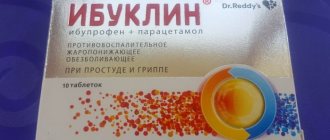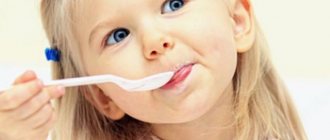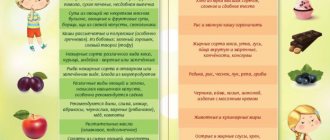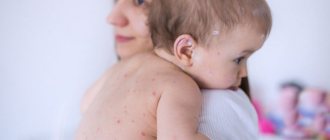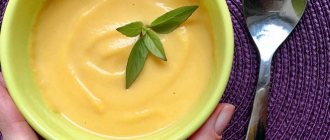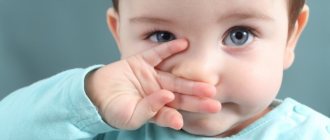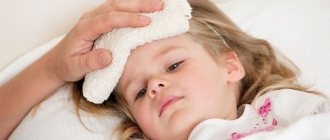The baby has a fever. Any irritant causes apathy in him, and he is generally sick of looking at a plate of soup or porridge. A reasonable question arises: then what to feed a child at a fever if not a single crumb is pushed into him?
Read in this article:
- Tips for parents on how to feed a sick child.
- Do I need to continue feeding if vomiting occurs?
- The diet of a baby who is recovering.
An adult during an illness understands that he needs to “feed on”, albeit through force and at least with something. With a small child everything is much more complicated. When children get sick, for example with a cold, flu or sore throat, they completely lose their appetite. This fact, as a rule, is very upsetting for adults.
Feeding a baby during illness
If a child has a cold and refuses to eat, you should not force him to eat. This will cause a negative reaction on his part and distrust of his parents. The baby refuses to eat because the body’s entire resource is aimed at fighting the infection: there is no longer enough energy to digest and assimilate food. Therefore, it is extremely unwise to punish a sick child for lack of appetite or show your dissatisfaction with his behavior.
In the first days after illness, a child may vomit at the sight of food: this is a normal protective reaction of an organism weakened by infection. Children with a high temperature need to drink more than eat. Offer your baby chamomile tea - he won't refuse. You can also give plain boiled water to prevent dehydration.
If the child himself asks to eat, give him light food - applesauce (boiled) or a little semolina porridge. If vomiting does not resume, offer to drink fruit juice or jelly. The jelly contains starch, so the baby will not feel hungry. Jelly fruit extract will saturate the body with essential minerals and partially replenish vitamin deficiencies.
Note! When you have a cold, the oral mucosa becomes inflamed, so offering cookies to your child is not recommended: this can cause additional sore throat.
If the temperature is above 38 degrees, the child cannot eat food with a solid consistency - only semi-liquid or liquid. Offer yogurt, soft cottage cheese or vegetable puree. Do not try to force feed: the baby will resist and spend his last strength on it.
If your baby asks for milk, give a low-fat product. At high temperatures, the body is weakened and unable to absorb fats. It is strictly forbidden to give your baby cream to drink in order to eliminate the feeling of hunger. It’s better to cook him jelly or offer him fruit jelly. When the child gets better, he himself will ask to eat.
What foods should not be given to children?
Traditional methods of treating colds, applicable to adults, may be dangerous or useless for a child.
Honey
Honey is considered a natural antipyretic, which, due to its high concentration of biologically active substances, promotes sweating and reduces body temperature.
Hot tea with honey for influenza and ARVI is a folk recipe for getting rid of the symptoms of the disease, which cannot be applied to everyone:
- The beekeeping product cannot be mixed with hot drinks: boiling water destroys the beneficial substances in honey and turns the medicine into useless sweet water.
- This healthy treat should not be given to children with diabetes or excess weight: honey contains simple sugars, including glucose and fructose.
The product is also not recommended for children under three years of age:
- honey may contain spores of the bacterium Clostridium botulinum and cause the development of botulism (babies do not have microflora that can resist the disease);
- the treat is a strong allergen and can cause a rash, hyperemia and swelling of the skin;
- Honey is a high-calorie product (327 kcal per 100 g), which can cause weight problems with unlimited consumption of sweets.
For children over three years old, at high temperatures, you can offer a teaspoon of honey as a snack with tea, but without mixing it with the drink.
Raspberries
Fragrant berries are another folk method of getting rid of high fever.
Raspberries contain salicylic acid, which helps fight infection and has anti-inflammatory and antipyretic properties.
Is it possible to give raspberries to a child with a fever?
If your baby is already one year old and has tried the berry, you can offer him compote or warm tea with raspberries: the drinks will help increase sweating and reduce high fever.
Important! It is undesirable to introduce something new into a baby’s diet: during this period, the body may react to an unfamiliar product with allergic reactions.
Milk
Whether to give milk to a child with a fever depends on how well the baby tolerates the casein and -lactoglobulin contained in the product. Milk replenishes the lack of potassium, prevents dehydration, and helps maintain strength if the baby cannot eat solid food.
However, high-quality milk is difficult to find, and even the inscription “for baby food” does not guarantee that you are buying a natural product and not one reconstituted from milk powder.
In addition, if a child cannot tolerate cow’s milk protein, heavy consumption of this drink leads to disruption of the gastrointestinal tract, which worsens the baby’s condition during ARVI and influenza.
Chicken bouillon
Chicken broth when a child has a fever is a standard nutritional recommendation during illness:
- This dish is easy to swallow, even if the baby has a sore throat;
- broth replenishes the lack of fluid in the body;
- does not overload the intestines.
However, chicken broth cannot always be a cure for a sick child:
- it is difficult to find meat without additives and antibiotics, which means that the broth will do more harm than good;
- an improperly prepared dish with excess fat will cause disruption of the digestive system.
A small portion of chicken broth can be offered to your baby during the recovery period, but only if the child does not mind eating and tolerates the product well.
Oranges and lemons
Bright citrus fruits are a source of vitamin C, necessary for infectious pathologies. However, the acidic juice of oranges and lemons can irritate the stomach lining and even cause nausea.
In addition, the content of ascorbic acid in an orange is 50 mg, and in a lemon - only 40 mg per 100 g. For comparison: 100 grams of sweet pepper contains 200 mg of vitamin C, and rose hip decoction - 650 mg.
Therefore, it is advisable to offer your child tea with rosehip or a light salad with bell pepper instead of sour orange juice.
Fever with vomiting
What to do if a child starts vomiting? What should the diet be like? In this situation, only drinking regimen is indicated. When vomiting, the body loses energy, so you should not give your baby food - he will still vomit again and lose additional energy. The same applies to infants: a nursing mother needs to follow a diet when the baby is sick and not eat fatty, indigestible foods.
Sometimes when vomiting, the best remedy is to drink warm boiled water. When the vomiting stops, offer juice or liquid jelly. Observe the body’s reaction and the baby’s desires - he will choose what is best for him to drink or eat in a given situation. You can’t drink in large quantities either - drinking should be fractional. Offer half a glass of compote or water.
Formula for baby at fever
Sick children need food. Therefore, when feeding with formula, follow simple recommendations:
- In the first days of the disease, the serving size is reduced, then given in accordance with age norms.
- Pay attention to the body's reaction to the mixture. If absorption is poor, you will have to give it up for a while. Appetite decreases at elevated temperatures, so you should not force feed. Give more breast milk if possible.
- If the body reacts by vomiting to temperature, then it is better not to give complementary foods for several hours. It is necessary to give the baby small portions of boiled water.
- When purchasing, choose a mixture enriched with vitamins.
In order not to aggravate the course of the disease, feed according to the child’s wishes. You cannot force someone to eat, otherwise the body will spend energy on digesting food and will not fight the infection. .
Recovery period
One of the happiest moments for a mother is the appearance of an appetite in a child after an illness. What should the diet be like? There is no need to immediately offer a lot of food - the body has not yet recovered the energy spent fighting the disease. During this period, the best way to recuperate will be herbal tea with honey and fresh fruit:
- banana puree;
- baked mashed apples;
- natural berry/fruit juices.
This nutrition will saturate the weakened body with a complex of minerals and vitamins. It is useful to offer your baby buckwheat/oatmeal porridge with milk: just do not add a lot of butter. Fats are difficult to digest for a weakened body.
You cannot stuff your child with food from morning to evening in order to restore his previous weight. Focus on the child's desires and needs, and the weight will soon be restored. Food should be vitamin-rich, not filling.
What are the dangers of overfeeding during the recovery period? Pathogenic bacteria remain in the intestines for several days after the temperature drops, and large volumes of food will provoke undesirable phenomena in the child’s intestines. This threatens complications and the baby’s refusal to eat at all.
If there is a fever, can I feed the baby?
Every woman in her life has encountered illness, fever, and ailments. When a woman becomes a mother, she always thinks about the baby first. The temperature can rise for many reasons, and therefore the question: “Is it possible to feed a child with a fever?” becomes the main thing for a nursing mother.
Causes of fever
The period of breastfeeding is very important for the baby, and even a short refusal of feeding is not very beneficial. There is no complete certainty that after refusal there will be no problems with establishing feeding. Therefore, first of all, it is necessary to determine the cause of the increase in temperature.
What can cause a nursing mother's temperature to rise:
- colds (acute respiratory infections, acute respiratory viral infections);
- mastitis;
- postpartum complications (suture infection, incomplete discharge of placenta, complications after cesarean section);
- poisoning, intestinal infections;
- kidney diseases;
- sore throat, pneumonia;
- exacerbation of a chronic disease (gastritis, bronchitis);
You can hear the opinion that as soon as a woman’s temperature rises above 37.5 degrees, she should immediately stop feeding, express the milk, boil it and give it to the child.
These methods have long been outdated. It is useless to give boiled milk to a child, since boiling will kill all the beneficial microelements in it. It is better to provide the baby with a suitable formula for feeding. Modern medicine allows breastfeeding to continue if a woman’s temperature is not higher than 38.5 degrees. Most often, fever is associated with colds.
Attention! The baby is also at risk of contracting a cold because he is always close to his mother, but the intake of mother’s milk into his body with antibodies released when fighting infection is very useful. They can help the baby not get sick at all or survive the disease without complications.
When is it better to stop breastfeeding?
There are cases when the mother’s temperature does not affect the baby, or even helps him increase the body’s immune defense. Then the mother can calmly continue feeding and not think about the bad, but this does not always happen.
In what situations should a mother stop breastfeeding:
- When the temperature rises above 39 degrees, and there was no time to bring it down, or it simply couldn’t be done. It is believed that the taste properties of milk at this temperature change, and the child may completely abandon the breast.
- When fever is associated with diseases of the liver, heart, lungs, kidneys.
- When antibiotics are used to fight a disease. They can pass into milk and enter the baby's body.
Separately, we should consider the fever that accompanies purulent mastitis; is it possible to feed a child when the mother has a fever caused by inflammation of the mammary gland? In most cases, the disease begins with the penetration of Staphylococcus aureus into the mother's body (infection often occurs in the maternity hospital). If there is a focus of purulent inflammation in the mammary gland, mother's milk almost always becomes infected and enters the baby's body during feeding.
Treatment occurs by taking antibiotics, which are aimed at destroying the source of inflammation and pass into the milk. In this case, the child is at risk of contracting an infection and being exposed to a dangerous dose of medication. To protect the baby, he is transferred to artificial feeding.
Important! If a mother is concerned about whether it is possible to feed her baby at a temperature of 38, she needs to know that it all depends on the causes of the fever. It is not even recommended to reduce the heat within 38 degrees.
You should consult a doctor who will rule out a possible list of serious diseases that would prohibit you from continuing breastfeeding.
If mom has a cold
If a mother is afraid of harming her baby or infecting him, she can use basic measures to prevent the disease.
How to minimize the risk of infection:
- if the baby is not afraid, the mother can put on a protective mask and change it every two hours;
- ventilate the room as often as possible;
- carry out wet cleaning once or twice a day;
- do not forget to wash your hands with soap.
Remember! If a mother needs to interrupt breastfeeding, she is recommended to express her breasts to maintain lactation and continue feeding after completing the course of therapy.
How to feed a sick child
If the mother has a fever, but it is not dangerous for the baby, then she continues to breastfeed. If the mother’s infection, illness and treatment pose a threat to the child’s health, he is transferred to an age-appropriate formula, taking into account the individual characteristics of the body.
But what to feed a child with a fever if he is sick? By the way, first you will be interested in finding out in our article what temperature should be brought down in a child.
How to feed a baby with a fever:
- A breastfed baby may require constant attention to the breast. The mother should not refuse him this, since her milk is the main source of microelements beneficial for the child’s body.
- If illness and fever occurred at the stage of partial introduction of complementary foods, the mother should not be surprised by the possible refusal of food in favor of breast milk.
- If the baby does not refuse, you can give him additional drinks in the form of water, compote, or baby tea.
- An increase in temperature is a signal that the body has begun to fight the virus, so the child should not be forced to eat. You can offer him liquid food: broths, kefir, yogurt, liquid porridge.
- On your doctor's recommendation, you can add vitamins to your diet.
- If the baby is prescribed antibiotics within a month after the illness, it will be necessary to take drugs that restore the intestinal microflora. Take them only as prescribed by a doctor.
Mothers often forget about their health after the birth of their baby, but if the temperature suddenly rises, they should consult a doctor to take care of their health and not harm the baby.
detki-zdorovy.ru
Summarize
What to feed a child with a fever? The diet should be light - pureed vegetables/fruits, jelly, yogurt, low-fat cottage cheese, liquid porridge with water. Prepare dishes by steaming or in the oven, with the exception of compotes and jelly. This especially applies during the recovery period - you should not give fried foods.
You should not wake up a sleeping baby to give him something to drink or offer him something to eat. Sleep during illness is a wonderful healer; in sleep, the body restores its energy reserves. Do not try to feed your baby well - the menu should be rich in vitamins, food portions should be small.
During the recovery period, offer fresh fruits and juices more often, and buy a vitamin and mineral complex. However, remember that natural vitamins are valuable to the body, not artificial ones. Taking into account these recommendations, you can make your baby feel better during illness and during the recovery period.
Formula feeding during fever - myths and reality
Often parents are sure that during high temperatures, the children’s body cannot absorb milk, so formula should not be given. Experts explain that if before the illness the child tolerated the formula well, then during the illness it will be completely absorbed. The main thing is not to experiment, and give only proven food that the baby is used to eating.
It is not recommended to give dairy products during elevated temperatures, which does not apply to infant formula. This is not only food, but also additional drink, which is very necessary during illness.
It is not advisable to give cottage cheese and milk to a child who has a high temperature.
“When my three-year-old daughter is sick, she refuses to eat until the temperature drops. Should a child with a cold be forced to eat? Olga M.
“If a girl refuses to eat in the first days of a high temperature, this is normal - this is how the body’s protective reaction manifests itself,” says candidate of medical sciences, pediatrician Galina Ermolova. - Under no circumstances force-feed your daughter; instead, offer her energy-intensive foods and drinks, in particular sweets. When there is a deficiency of glucose in the body, protective antibodies are less well produced, and the child recovers more slowly, and due to a lack of carbohydrates, brain function deteriorates.
It is useful for a child with a cold to consume honey, but only if there is no allergy. You need to choose it from one type of plant - linden or acacia: they are less allergenic and have a more pronounced anti-inflammatory effect than other types. Children love a warm drink made from jam. To prepare it, dissolve cherry or any other jam in boiled water - blackcurrant, blueberry, apple, pear, plum, quince, grape. You can also make mint tea: brew mint with boiling water, add jam, squeeze out a little lemon juice.
A healthy drink for a sick child is various fruit drinks, compotes made from dried fruits or fresh apples. Basic products are apples, dried pears and plums, raisins, and it is better to alternate dates, figs, dried apricots. Such drinks are rich in vitamins and microelements. You can cook jelly using compote. It’s good to give juices that the girl loves, but it is advisable to choose them with pulp: the pectin contained in the pulp will cleanse the intestines like a sorbent. It is important to know: in the first two to three days of a child’s illness, juices should be diluted with water, tea or compote. The fact is that against the background of infection, the mucous membrane of the stomach and intestines swells, and acids - malic, citric, grape - of which there are enough in juices, can increase this swelling and contribute to the development of gastritis.
Other sweets (milk caramel, pastille, marmalade, marshmallows, cookies), dried fruits (dried apricots, raisins, prunes, dates, figs) are also useful.
What can a patient with a high fever eat?
How to help your body cope with the temperature and not overload it with food.
How to help your body cope with the temperature and not overload it with food.
Maintaining the general strength of the body, increasing protective reactions, reducing the inflammatory process, removing toxins - these are, of course, the main priorities for creating a diet for a patient with a high fever.
Nutrition for a flu patient: hunger or “extra” calories?
When body temperature rises by 1 degree, basal metabolism increases by 13%, so you can easily calculate how much metabolism will increase at a very high temperature. If the patient is not fed, the body begins to use its own reserves, and this entails depletion of the already weakened body.
However, overfeeding the patient overloads the digestive system. Therefore, it is necessary to take easily digestible food in small portions 5 times a day. It is especially important that the patient’s food does not contain large amounts of fat, but consists of complete proteins, minerals and vitamins, especially vitamin C.
The daily calorie intake should not fall below 2000. If previously there was an opinion that a febrile state could be treated by fasting, it has now been proven that a semi-starved diet weakens the patient’s body even more.
If the flu is very severe, dietary nutrition is prescribed individually.
Special requirements for preparing dietary dishes
For the preparation of dietary food, only fresh quality products should be used. Despite the fact that the patient’s diet cannot include sauces and seasonings, this does not mean that the food should be tasteless. It’s just that to prepare it you need to use the freshest products, choose the best recipes, and not prepare food for future use. And remember: a complete ban on heated food is being introduced.
Diet for a flu patient: recommended amount of fluid
Increased sweating in patients with high fever, as well as the need to remove from the body products resulting from increased metabolism, dictate the need to include a large amount of liquid in the diet (2 liters or more).
These can be fruit and vegetable juices, rosehip infusions, teas with lemon, as well as herbal teas (chamomile, mint), fruit drinks, compotes, and jelly.
It is imperative to include fermented milk products in your diet, as they normalize the state of intestinal flora and intestinal activity, while providing the body with easily digestible protein, calcium, and vitamins.
It remains up to the patient to decide whether to include whole milk in the diet, since not everyone tolerates it equally well. But it is recommended to exclude cocoa from the diet.
It is advisable to give the patient water not only during the day, but also at night.
Nutrition for a flu patient: recommended and prohibited foods
The diet of patients with high fever should include easily digestible foods.
Soups: weak meat and fish broths, puree soup, slimy soup-like decoctions of cereals. You can season the first courses with sour cream, egg yolk and butter, which are added to the prepared food.
Nutrition for a flu patient: protein foods
Can! Low-fat meats and fish should be served boiled, baked, stewed, as well as in the form of soufflés, purees, and jellied dishes.
Eggs are served soft-boiled or as a steam omelet.
It is forbidden! Fried omelettes, fried eggs and hard-boiled eggs are excluded from the diet.
Pork, lamb, duck and goose meat, as well as sausages, smoked meats and any types of canned food are unconditionally excluded. And of course all the fried foods.
Nutrition for a flu patient: vegetables and fruits
Can! Vegetables (potatoes, beets, carrots, tomatoes, cauliflower, zucchini, pumpkin) can be served raw, boiled or stewed. You can season the pureed vegetables with a piece of butter.
Fruits and berries should be juicy and ripe; it is advisable to serve them pureed; you can prepare various mousses, soufflés, jellies, preserves or jams from them. It is preferable to bake apples
It is forbidden! Legumes, cabbage, radishes, radishes, as they cause the formation of gases in the intestines. It is also worth removing mushrooms from your diet - they are very difficult to digest.
Diet for a flu patient: carbohydrates
Can! Sugar, marmalade and honey are allowed.
Bread and flour products should be given in moderation. You can leave dried wheat bread, crackers, and dry uneaten cookies in your diet.
Cereals are much preferable to flour products. Boiled porridges with the addition of broths or milk, puddings and souffles are ideal from semolina, buckwheat, rolled oats and rice
It is forbidden! Any fresh bread or baked goods are excluded. Barley, pearl barley, wheat, and corn grits will have to be left until recovery.
Source: https://point.md/ru/novosti/obschestvo/chto-mozhno-estj-boljnomu-s-visokoj-temperaturoj
Do not overfeed your child at the end of the illness
If a child has had a high fever for several days and has not eaten anything, he will naturally lose weight. When this happens to a child for the first time, the mother is very worried. When the temperature subsides and the doctor allows a gradual transition to a normal diet, the mother cannot wait to feed the child more nourishingly. But often after illness he first refuses food. If the mother insists every time, day after day, the appetite for the child may never return. This child has not forgotten how he used to eat, and is not so weak that he is unable to eat. By the time his fever subsides, there will still be enough infection in his body that affects his stomach and intestines. As soon as a child sees food, his stomach and intestines immediately warn him that they are not yet ready to accept it. If you stuff a child with food and force him to eat while he is feeling slightly nauseous due to illness, an aversion to food will take root in him faster than in a healthy child. In a few days you can stop his appetite for a long time. As soon as the stomach and intestines recover from the illness and are again able to digest food, the child returns to a strong feeling of hunger. In the first week or two after illness, he eats a lot and greedily to compensate for what he has lost. Sometimes he may whine, asking for more food 2 hours after a hearty meal. A three-year-old child will require certain types of food that his exhausted body especially needs. During the recovery period, parents should give the child only the food and drink that he wants, without any insistence and patiently, but with confidence, wait for signs of readiness for an increase in nutrition. If your child's appetite has not returned after a week, consult your doctor.
What you need to know about fever
The reasons for the increase in temperature are provoking factors leading to inflammatory processes and thermoregulation disorders:
The temperature should be reduced at levels not lower than 38 C in young children and 38.5 C in babies after one year: early use of antipyretics prevents the body from fighting infection or other factors that cause fever. Exceptions are patients with:
Children with these diseases need to bring down their temperature, not allowing it to rise to 37.6C.
Important! Therapy should be carried out under the supervision of a pediatrician. Independently prescribing treatment for a child, especially an infant, is unacceptable.
Basic principles
Do not force your baby to eat: in the first days of illness, accompanied by an increase in body temperature, the body should be given the opportunity to fight infection and stress without wasting energy on digesting heavy food.
Calculate the rate of plenty of drinking for your child: when the temperature rises, increase the volume of water by 20-35 ml per hour (for a child weighing up to 10 kg), by 40 ml (for a baby up to 20 kg), by 60 ml per hour (for a child weighing more than 30 kg).
What drink?
The ideal drink for a sick baby is warm, clean water. If it is impossible to give the baby water to drink (for example, many children do not like its taste), offer the little patient a diluted compote or water with the addition of unsweetened natural juice. Do not allow drinking concentrated nectars and sour tea: irritation of the mucous membrane of the digestive system can lead to vomiting, diseases of the stomach and intestines.

